
The Confederate States of America (CSA), commonly referred to as the Confederate States (C.S.), the Confederacy, or the South, was an unrecognized breakaway republic in the Southern United States that existed from February 8, 1861, to May 9, 1865. The Confederacy comprised eleven U.S. states that declared secession and warred against the United States during the American Civil War. The states were South Carolina, Mississippi, Florida, Alabama, Georgia, Louisiana, Texas, Virginia, Arkansas, Tennessee, and North Carolina.

The Confederate States Army, also called the Confederate Army or the Southern Army, was the military land force of the Confederate States of America during the American Civil War (1861–1865), fighting against the United States forces to win the independence of the Southern states and uphold and expand the institution of slavery. On February 28, 1861, the Provisional Confederate Congress established a provisional volunteer army and gave control over military operations and authority for mustering state forces and volunteers to the newly chosen Confederate president, Jefferson Davis. Davis was a graduate of the U.S. Military Academy, and colonel of a volunteer regiment during the Mexican–American War. He had also been a United States senator from Mississippi and U.S. Secretary of War under President Franklin Pierce. On March 1, 1861, on behalf of the Confederate government, Davis assumed control of the military situation at Charleston, South Carolina, where South Carolina state militia besieged Fort Sumter in Charleston harbor, held by a small U.S. Army garrison. By March 1861, the Provisional Confederate Congress expanded the provisional forces and established a more permanent Confederate States Army.
The Provisional Constitution of the Confederate States, formally the Constitution for the Provisional Government of the Confederate States of America, was an agreement among all seven original states in the Confederate States of America that served as its first constitution. Its drafting by a committee of twelve appointed by the Provisional Congress began on February 5, 1861. The Provisional Constitution was formally adopted on February 8. Government under this constitution was superseded by the new Constitution of the Confederate States with a permanent form of government "organized on the principles of the United States" on February 22, 1862.

The internal slave trade in the United States, also known as the domestic slave trade, the Second Middle Passage and the interregional slave trade, was the mercantile trade of enslaved people within the United States. It was most significant after 1808, when the importation of slaves from Africa was prohibited by federal law. Historians estimate that upwards of one million slaves were forcibly relocated from the Upper South, places like Maryland, Virginia, Kentucky, North Carolina, Tennessee, and Missouri, to the territories and then-new states of the Deep South, especially Georgia, Alabama, Louisiana, Mississippi, and Arkansas.

The American Civil War significantly affected Tennessee, with every county witnessing combat. During the War, Tennessee was a Confederate state, and the last state to officially secede from the Union to join the Confederacy. Tennessee had been threatening to secede since before the Confederacy was even formed, but didn’t officially do so until after the fall of Fort Sumter when public opinion throughout the state drastically shifted. Tennessee seceded in protest to President Lincoln's April 15 Proclamation calling forth 75,000 members of state militias to suppress the rebellion. Tennessee provided a large number of troops for the Confederacy, and would also provide more fleeing soldiers for the Union Army than any other state within the Confederacy.
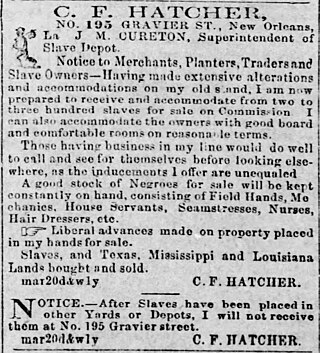
Charles F. Hatcher, typically advertising as C. F. Hatcher, was a 19th-century American slaver dealing out of Natchez, Mississippi, and New Orleans, Louisiana. He also worked as a trader of financial instruments, specie, and stocks, and as a land agent, with a special interest in selling Mississippi, Louisiana, and Texas real estate to speculators and settlers.

Louisiana was a dominant population center in the southwest of the Confederate States of America, controlling the wealthy trade center of New Orleans, and contributing the French Creole and Cajun populations to the demographic composition of a predominantly Anglo-American country. In the antebellum period, Louisiana was a slave state, where enslaved African Americans had comprised the majority of the population during the eighteenth-century French and Spanish dominations. By the time the United States acquired the territory (1803) and Louisiana became a state (1812), the institution of slavery was entrenched. By 1860, 47% of the state's population were enslaved, though the state also had one of the largest free black populations in the United States. Much of the white population, particularly in the cities, supported slavery, while pockets of support for the U.S. and its government existed in the more rural areas.

African Americans, including former enslaved individuals, served in the American Civil War. The 186,097 black men who joined the Union Army included 7,122 officers and 178,975 enlisted soldiers. Approximately 20,000 black sailors served in the Union Navy and formed a large percentage of many ships' crews. Later in the war, many regiments were recruited and organized as the United States Colored Troops, which reinforced the Northern forces substantially during the conflict's last two years. Both Northern Free Negro and Southern runaway slaves joined the fight. Throughout the course of the war, black soldiers served in forty major battles and hundreds of more minor skirmishes; sixteen African Americans received the Medal of Honor.

Capt. Montgomery Little, CSA was an American slave trader and a Confederate Army cavalry officer who served in Nathan Bedford Forrest's Escort Company. Little was killed in action during the American Civil War at the Battle of Thompson's Station.
The Kentucky was a 19th-century sidewheel steamboat of the Ohio River, Mississippi River, and Red River of the South in the United States. Kentucky was involved in not one, not two, but three serious accidents over her lifespan (1856–1865), which resulted in the deaths of one, 20+, and 50+ people, respectively. She was built in Cincinnati, and her length was 222 ft (68 m) with a capacity of 375 short tons (340,000 kg).
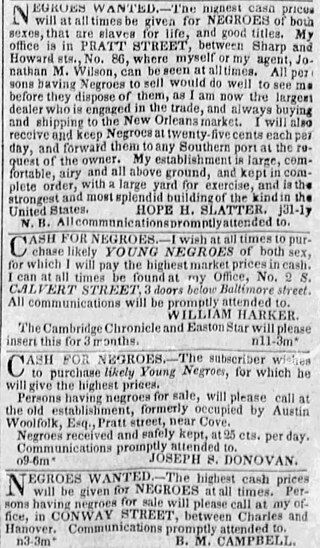
Bernard Moore Campbell and Walter L. Campbell operated an extensive slave-trading business in the antebellum U.S. South. B. M. Campbell, in company with Austin Woolfolk, Joseph S. Donovan, and Hope H. Slatter, has been described as one of the "tycoons of the slave trade" in the Upper South, "responsible for the forced departures of approximately 9,000 captives from Baltimore to New Orleans." Bernard and Walter were brothers.

Crawford, Frazer & Co. was a slave-trading business located in Atlanta, Georgia, in the 1860s. The principals of Crawford, Frazer & Co. were Robert Crawford, Addison D. Frazer, and Thomas Lafayette Frazer. In company with a man named Robert Clarke, Crawford, Frazer & Co. may have been among "the largest of the city's slave brokers." The business opened in January 1863, and was dissolved in April 1864. All parties continued separately as negro traders, at another location in Atlanta (Crawford), and in Montgomery, Alabama (Frazers), until forced to cease operations due to the defeat of the Confederacy, concluding the American Civil War. Crawford, Frazer & Co. is remembered today because the company's negro mart appears in a notable photo of pre-burning Civil War Atlanta.

Slave markets and slave jails in the United States were places used for the slave trade in the United States from the founding in 1776 until the total abolition of slavery in 1865. Slave pens, also known as slave jails, were used to temporarily hold enslaved people until they were sold, or to hold fugitive slaves, and sometimes even to "board" slaves while traveling. Slave markets were any place where sellers and buyers gathered to make deals. Some of these buildings had dedicated slave jails, others were negro marts to showcase the slaves offered for sale, and still others were general auction or market houses where a wide variety of business was conducted, of which "negro trading" was just one part.
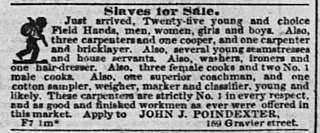
John Jenkins Poindexter was an American slave trader, commission merchant, school commissioner, and steamboat master of Louisiana and Mississippi. He served in the Mexican-American War as a junior officer in the Mississippi Rifles. The historic John J. Poindexter House in Jackson, Mississippi, was commissioned for the young Poindexter family and designed in the 1840s by architect William Nichols.

Jonathan Means Wilson, usually advertising as J. M. Wilson, was a 19th-century slave trader of the United States who trafficked people from the Upper South to the Lower South as part of the interstate slave trade. Originally a trading agent and associate to Baltimore traders, he later operated a slave depot in New Orleans. At the time of the 1860 U.S. census of New Orleans, Wilson had the second-highest net worth of the 34 residents who listed their occupation as "slave trader".

Thomas B. Poindexter was an American slave trader and cotton planter. He had the highest net worth, US$350,000, of the 34 active resident slave traders indexed as such in the 1860 New Orleans census, ahead of Jonathan M. Wilson and Bernard Kendig.
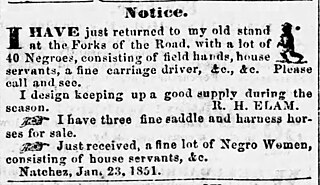
Robert H. Elam, usually advertising as R. H. Elam, was an American interstate slave trader who worked in Tennessee, Kentucky, Louisiana, and Mississippi.
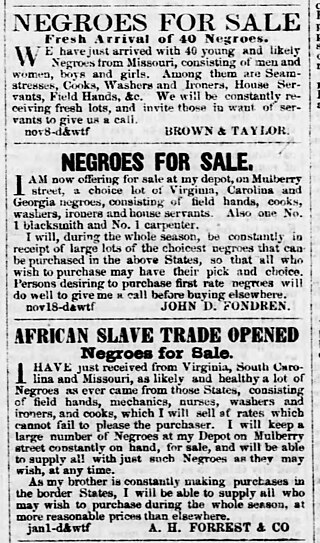
Aaron H. Forrest was one of the six Forrest brothers who engaged in the interregional slave trade in the United States prior to the American Civil War. He may have also owned or managed cotton plantations in Mississippi. He led a Confederate cavalry unit composed of volunteers from the Yazoo River region of Mississippi during the American Civil War. He died in 1864, apparently from illness.
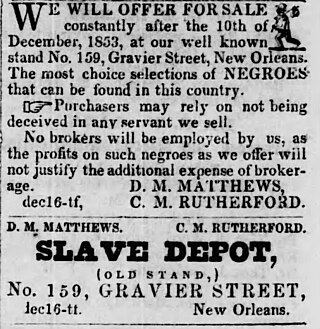
Calvin Morgan Rutherford, generally known as C. M. Rutherford, was a 19th-century American interstate slave trader. Rutherford had a wide geographic reach, trading nationwide from the Old Dominion of Virginia to as far west as Texas. Rutherford had ties to former Franklin & Armfield associates, worked in Kentucky for several years, advertised to markets throughout Louisiana and Mississippi, and was a major figure in the New Orleans slave trade for at least 20 years. Rutherford also invested his money in steamboats and hotels.


















